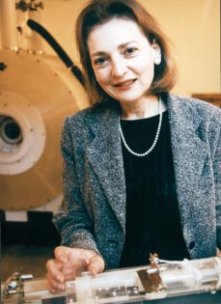
Anyone who has had a scare with cancer can relate to this line from the Woody Allen movie Deconstructing Harry: "The three most beautiful words in the English language aren't 'I love you,' but 'It is benign.'"
Thanks to technology developed in Prof. Hadassa Degani's laboratory, that relief may be had without the invasive, painful procedures that have accompanied cancer diagnosis methods until now. Prof. Degani discussed her breakthrough diagnostic method in a talk at MIT sponsored by ACWIS New England.
Prof. Degani's MRI-based method may someday be an alternative to mammography, presently the most widely available tool for breast cancer diagnosis. "The truth is mammography is not accurate. If the breast tissue is dense, as is the case for younger women, then mammography can miss malignant tumors. It also can't always differentiate between malignant and benign tumors. Too often pieces of a tumor must be removed for further testing. In 65 to 80 percent of cases these biopsies are unnecessary, because the tumors are benign," Prof. Degani said.
Prof. Degani uses MRI as a non-invasive way to differentiate between benign and malignant tumors at very early stages, sometimes even when tumors are undetectable by other methods. Unlike mammography, which uses x-rays to take a snapshot from two to three angles, MRI gives a three-dimensional image of the whole breast at high resolution. MRI also provides high contrast in soft tissues, thereby generating the clearest and most detailed images.
A doctor can then use a computer to manipulate the image and look at "slices" of breast tissue from any angle or direction to pinpoint a tumor. Besides providing physical information about size and location of a tumor, MRI can also give information about location of blood vessels, blood flow, and density of cells in tissue.
To test for breast cancer, a patient is injected with a liquid that circulates in the blood and shows up on a MRI image. For the most accurate measurements, MRI images are taken at three time points: one before injection and two after injection of the fluid. As the fluid flows into breast tissue, it will move differently through cancerous cells than through normal tissue. "If you find tissue with densely packed cells and a lot of leaky blood vessels, then it indicates cancer," Prof. Degani explained. A computer takes the information from the MRI readings and analyzes it and then color-codes the image for easier interpretation.
Prostate Cancer
In theory, this MRI technique should be applicable to many types of cancer and other diseases. She and her colleagues have already successfully extended the technology to diagnose prostate cancer. Until recently, the only way to confirm a suspicion for prostate cancer has been to do biopsies on tissues that are taken from up to eight different places. But merely by optimizing the time points when the three MRI images were taken, the researchers were able to identify malignant tumors and predict the type of treatment necessary.
"Literally, we are trying to improve early detection and diagnosis of malignancy and thereby help extend the life of patients around the world. Thanks to our many collaborations, we have images coming to our labs in Israel from clinical trials in such diverse areas as Chicago and Vienna. I hope someday this will be a widely used diagnostic tool," Prof. Degani concluded.
Update:
Prof. Degani's method, known as 3TP (Three Time Point), has received FDA clearance for use in the detection of breast and prostate cancer. The 3TP technology is being licensed worldwide by 3TP LLC of New York, a privately held company.
Prof. Hadassa Degani, incumbent of the Fred and Andrea Fallek Chair of Breast Cancer Research, heads the Magnetic Resonance Facility and the Willner Family Center for Vascular Biology.
